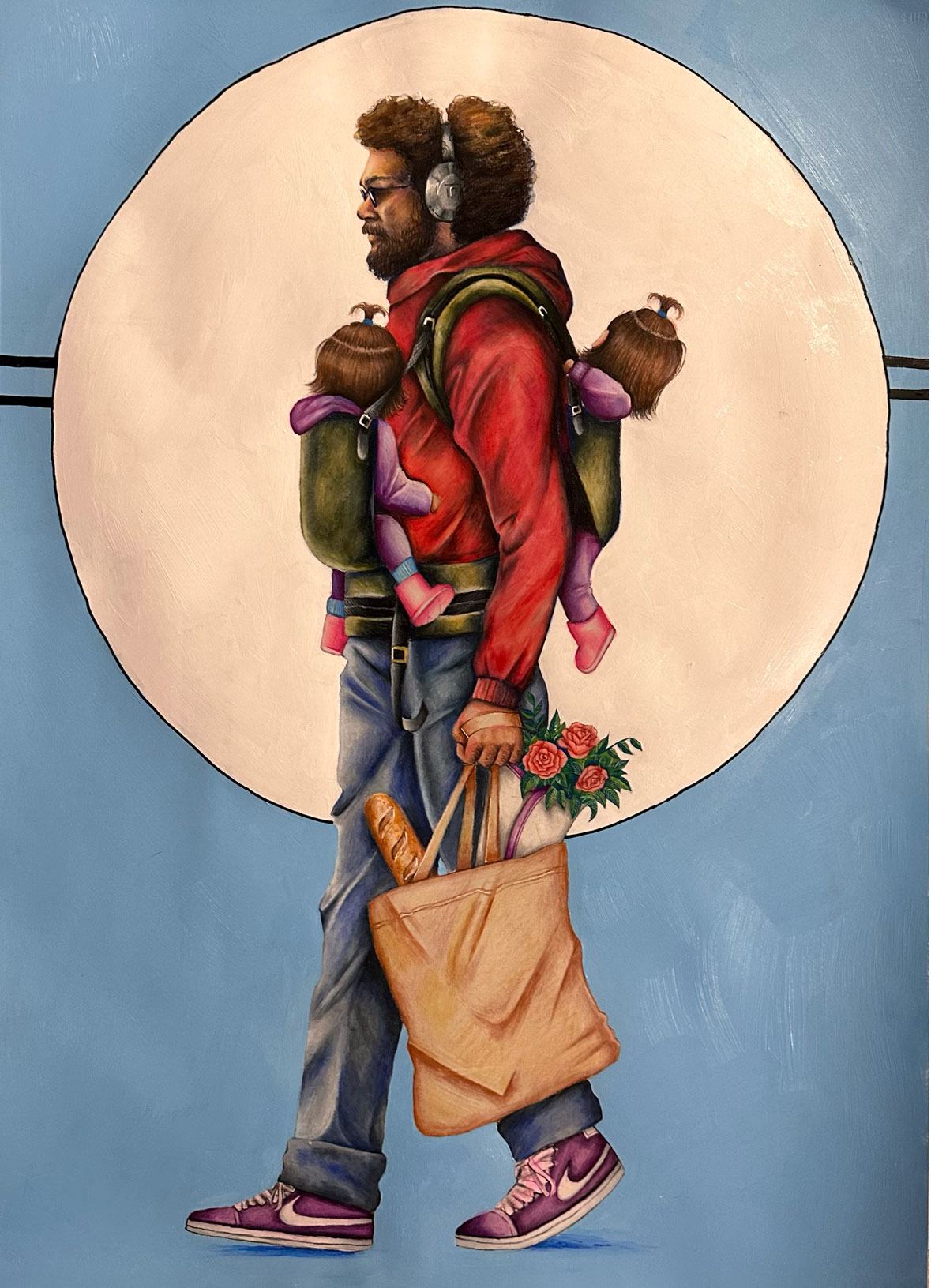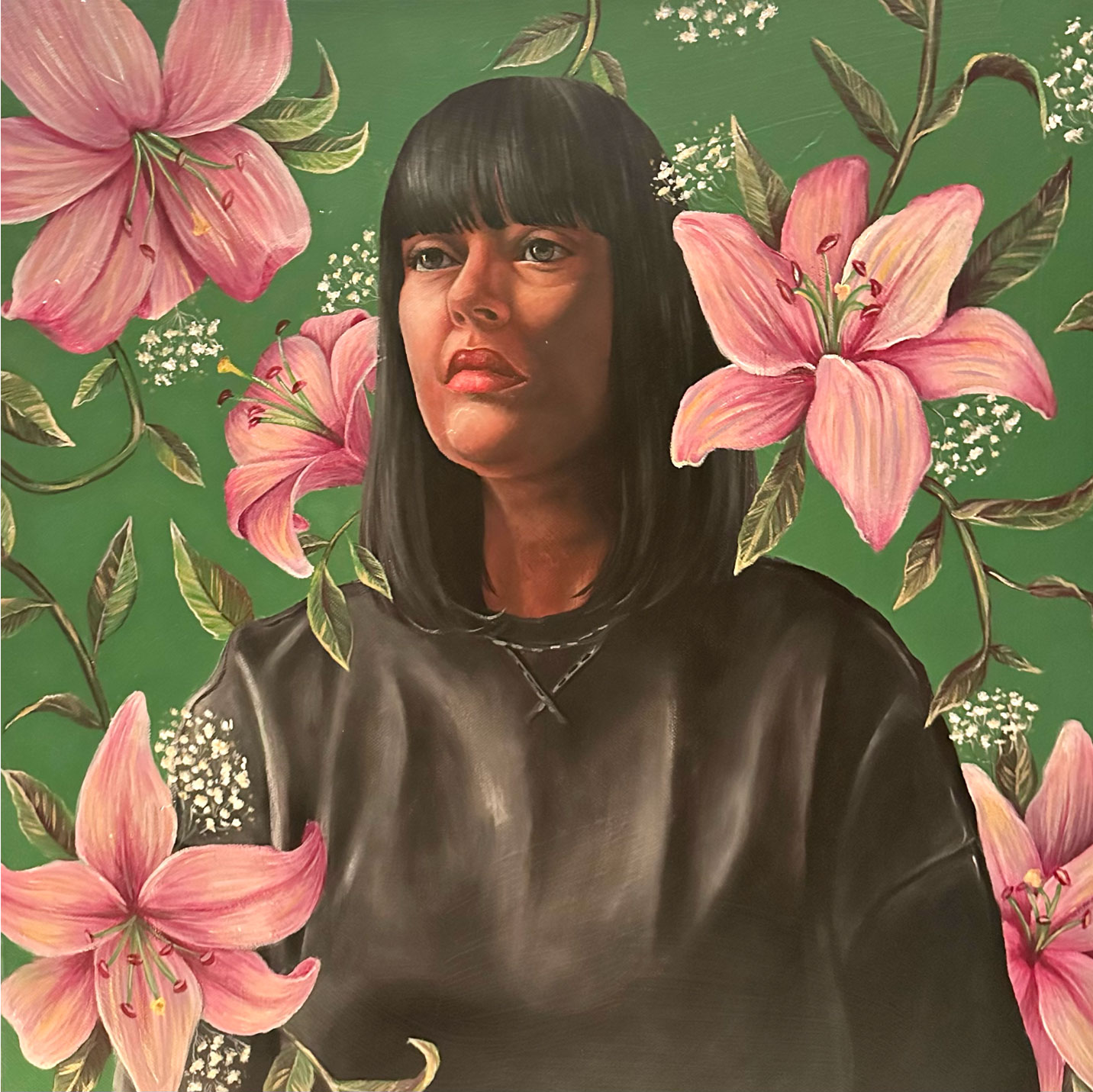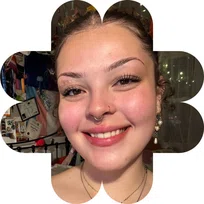


Quite the Handful
Height: 30" x Width: 22" | Material(s): Watercolor, colored pencils and acrylic paint on watercolor paper
Process(es): Imitated work of Norman Rockwell: observation of a man taking on the traditional role of a mother. | Idea(s): This piece symbolizes the duality of parenthood, both the stresses and joys that come with it. | Curatorial Note: This is a cleanly rendered illustration that challenges traditional roles. Clever use of framing and color.
Kaylie Tennant
Student statement
Student statement
Does your work reference or draw on a contemporary or historical art-making style, practice, or tradition? If so, please explain.
“Quite the Handful”: This piece was inspired by the works of Norman Rockwell. I wanted to imitate Rockwell's quirky, lifelike subjects, so I decided to draw a picture of a man I saw walking one day. I thought he looked really cool; listening to music, carrying groceries, with two adorable babies strapped to his front and back. I fell in love with the photo, and knew I needed to draw it in Rockwell's style.
“Natural Beauty”: This piece was inspired by the works of Kehinde Wiley. I felt like I had painted most of my friends and family already, so I reached out to my best friend's mom asking if I could paint her. Luckily, she said yes, and I decided to have her pose like the Mona Lisa, because Wiley famously imitates the works of the old masters. I painted lilies in the background, some of which overlap onto the subject, another technique that Wiley incorporates into his pieces.
What did you do to improve your 2-D, 3-D, or Drawing portfolio skills?
In order to improve my 2D drawing skills, I tried to push myself out of my comfort zone. I have always really loved graphite because of how forgiving it is; however, I knew that if I wanted to grow as an artist, I was going to need to try other mediums. I used things like colored pencils, gouache, acrylic paint, and digital to create my portfolio. While I think I may have sacrificed technical skill in some cases, I am extremely happy I decided to try new things.
My sustained investigation centers around the traditional depiction of femininity through different art movements, including but not limited to specific artists.
In what ways did your art-making confidence increase in AP Art and Design?
My art-making confidence increased during AP art because of how much thought and research went into each piece. In the past, I hadn't really ever made thumbnails for large pieces; I would always just find a reference off Pinterest and recreate it. However, with all the planning that was required in AP Art, I felt a lot more confident when creating pieces. I started taking my own reference photos and creating my own compositions and ideas.
Did you participate in art shows at your school or in your community?
My artwork was showcased as a part of my IB Art Portfolio. This was the first time I had my own space to display my art for people to see, and it was definitely interesting. It was really cool to be able to talk to people about my art and answer any questions they had, in person. My teacher also helped me position all my pieces in a way that was aesthetically pleasing, something I hadn't really considered before. It was an overall super fun experience, and I am honored to participate in another exhibition.

Natural Beauty

Height: 20" x Width: 20" | Material(s): Acrylic Paint on Canvas | Process(es): Painted subject first, then background elements, imitating the style of Kehinde Wiley. | Idea(s): This piece was a study of a more mature subject, showing how aging is a natural, graceful process. | Curatorial Note: This is a cleanly rendered illustration that challenges traditional roles. Clever use of framing and color.
Jaime DeVita
Visual Art Teacher
Bedford High School, Bedford, NH, USA
Teacher statement
Teacher statement
The AP Art and Design course supports inquiry-based personalized learning in the sustained investigation portfolio component. What strategies helped you guide students through inquiry?
After looking at many examples of AP Portfolios and their rubrics, we critiqued various inquiries based on criteria such as connection to self, creation potential, idea expansion, potential challenges or shortcomings, and tried to dig deeper into why certain inquiries would innately be more successful than others. Students then developed their inquiries alongside their initial concepts for projects and presented these ideas to the class for feedback. Throughout the year, group critiques kept the students engaged and motivated to continue learning and growing with diverse feedback.
How did you support skill development AND inquiry in the AP Art and Design curriculum?
For the first phase of each project, I require students to thoroughly research an artist, art movement, or technique that applies to their inquiry, which helps personalize and differentiate their skill development. You may recognize how Kaylie’s artwork was inspired by Norman Rockwell and Kehinde Wiley, who are just two of the many artists she researched during her inquiry process. Throughout the year, in addition to formal critiques, students are encouraged to take breaks from making art in order to circulate the classroom and observe what others are doing. When this happens, students help each other in ways that I would be unable to achieve alone, even with a small class size. Working together as a studio and not solo artists naturally motivates reflection, which leads to revisions that expand their inquiry.
How did you structure practice, experimentation, and revision into your AP Art and Design curriculum?
After students’ initial research, they practice with their chosen medium, style, and technique in ways that encourage learning through experimentation and allowing failed attempts to inform development. I always emphasize to my students that their ability to reflect and improve dictates their grade—not their first, second, or even tenth try at something. Students present to me their compilation of research, practice, and experimentation in order to get a green light to begin the final project. The students keep this compilation to feed their Sustained Investigation submissions and give them guidance for future revisions of their projects.
What did you learn from working with your student?
Kaylie is an artist who strongly developed her visual and fine motor skills at a very young age, using the extra time she had during the lockdown in 2020 to practice and refine her craft. I would argue that I can hardly take credit for her technical skill—when she was in my introductory classes such as Painting and Illustration, she was leagues ahead of every piece of curriculum I had to offer her. However, Kaylie is so driven to practice and improve on her own that she quickly proposed ideas for how to challenge herself and implemented them without hesitation. Witnessing Kaylie’s artistic processes in those classes, and even with her AP Art work, helped me envision how to scaffold my curricula to an even higher level than I had previously thought possible, enabling future artists to gain more from introductory classes. Because of her strong technical skill, we were able to focus on the inquiry process and expand upon ideas in directions that I have been unable to attain with other students. Her naturally inquisitive nature helped me discover ways to dive deeper with students and what questions to ask them in order to facilitate the development of a transformative inquiry.
Bob Jozokos
Principal
Bedford High School, Bedford, NH, USA
Leader statement
Leader statement
What are you most proud of regarding your school’s AP Art and Design program, student, and teacher?
Bedford High School has a robust arts program, which has been a central part of our identity since we opened. Our visual arts program and the courses offered to students give them a wide range of experiences and places to concentrate their focus. AP Art and Design is one of those places. Our Art Department and, in Kaylie’s case, her teacher, Jaime DeVita, provide a wealth of professional knowledge, guidance, and expertise in their fields. Jaime has a very strong background in visual arts and shares that background with passion and precision. Her instruction and support have kept our arts program strong, meaningful, and integral to our school community. Kaylie’s portfolio is skillfully executed, and one of her pieces, "Quite A Handful,” was selected as our 2024 Legacy Artwork, which Kaylie generously donated to the school. I’m proud to have it in our collection.
What do you do to support visual arts programming in your school?
The BHS Leadership Team and I strongly advocate for the importance of art education, believing that art is a vital part of the BHS educational experience. To support this belief, student artwork is displayed throughout the school, the district, and even within the local community. This recognition of students' artistic achievements reflects the school’s commitment to our students’ creativity and artistic expression.
What is your advice to other school leaders on how to support an AP Art and Design program?
Hire and support the best art teachers and make sure the creation of the master schedule maintains the importance of the arts program.
Kaylie Tennant



